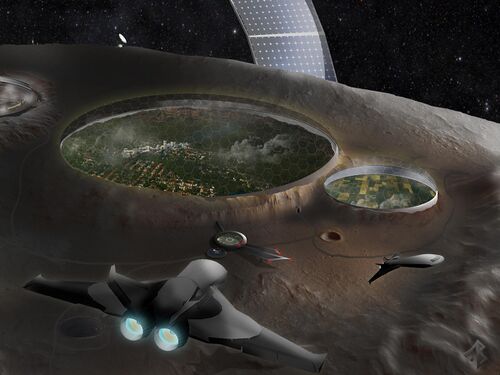Dome Habitats (A1-0)

Image from Faylar001 on DeviantArt.
Dome Habitats are enclosed, pressurized habitats often used to colonize the surface of asteroids, comets, and other normally uninhabitable celestial bodies.
Structure
Dome Habitats, as the name suggests, mainly consist of a dome-shaped shell, often supported by a net of carbon nanotubes and diamondoid, that can either be made of:
- Transparent Elastic Diamondoid Fiber Composites, held up by the interior air pressure or by additional support structures.
- Airwall foglets (airborne nanorobotic or bionano units) of various strength, going from an easily traversable membrane to a sheet with the same resistance as thick wood.
- Organic Space Canopy plants that grow a network of strong, elastic organic fibers within the outer surface to retain air without rupturing due to the pressure difference, that can also generate oxygen (or other gases) for the internal environment.
Depending on where the habitats are constructed, the shells can either be directly attached to the surface or to a natural wall-like structure (this happens especially in deep valleys and canyons, where the landscape is used to the habitat's advantage), or they can be attached to a structural base, that also contains the habitat's power generators and life support systems. The structural bases can also act as a floor over which the internal environment is created, and can host a series of artificial gravity generation technologies (such as Gravity Plates, Action At A Distance Gravity and others) that can create standard surface gravity parameters in the environment. The gravity plates however are optional, as habitats may choose to be zero gravity environments: usually, the residents of such habitats are naturally or artificially adapted to zero-gravity.
While in larger dome habitats the internal atmosphere may offer some level of protection against cosmic and stellar radiation, small and large domes are usually outfitted with magnetic and/or electrostatic shielding to completely block out all harmful stellar and interstellar radiation that may compromise the health of inhabitants not outfitted with radiation resistance augmentations and other kinds of protection, natural or not.
Energy Production
Dome Habitats can sustain their power generation systems in different ways. Many habitats autonomously generate their own power through photovoltaic surface collectors; others may use nuclear or (more commonly throughout the advanced cosmos) fusion reactors, both powered by elements and materials either extracted from the celestial body on which the habitat is located, or acquired from other parties by the habitat during trade. In the case that the dome habitat is constructed on a celestial body orbiting a terrestrial or gaseous planet, materials for power generation are typically given to the habitat from these central bodies. Dome Habitats, especially those located in interplanetary space and directly orbiting a star (although this often still happens even on major moons), may also receive their energy from Dyson Swarms constructed around a star.
Dome Habitats In Sector A1-0
Sources
- Orion's Arm: https://www.orionsarm.com/eg-article/4b68e75aa5162
- Orion's Arm: https://www.orionsarm.com/eg-article/48472c6ab8511